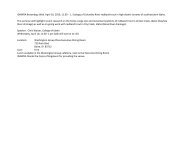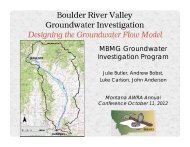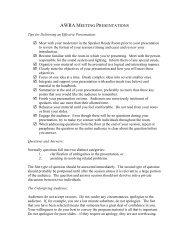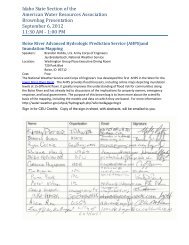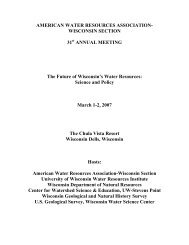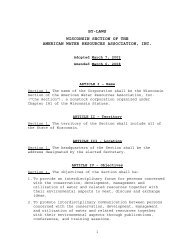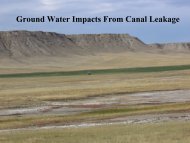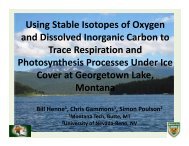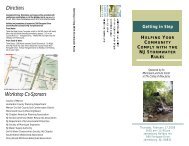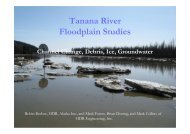Wisconsin's Role in Great Lakes Restoration - American Water ...
Wisconsin's Role in Great Lakes Restoration - American Water ...
Wisconsin's Role in Great Lakes Restoration - American Water ...
You also want an ePaper? Increase the reach of your titles
YUMPU automatically turns print PDFs into web optimized ePapers that Google loves.
Us<strong>in</strong>g Microsatellite Markers to Characterize the Genetic Diversity of Wild Rice <strong>in</strong> <strong>Great</strong><br />
<strong>Lakes</strong> Coastal Habitats: Implications for <strong>Restoration</strong><br />
Anthony J. Kern, Northland College, Ashland, WI, akern@northland.edu<br />
Alexander L. Kahler, University of M<strong>in</strong>nesota, St. Paul, MN, kahl0041@umn.edu<br />
Ronald L. Phillips, University of M<strong>in</strong>nesota, St. Paul, MN, phill005@umn.edu<br />
<strong>American</strong> wild rice (Zizania palustris) is an emergent aquatic grass with significant ecological,<br />
economic, and cultural importance. Due to human activities and exotic species <strong>in</strong>vasions, the<br />
plant has decl<strong>in</strong>ed precipitously across much of its range, <strong>in</strong>clud<strong>in</strong>g <strong>Great</strong> <strong>Lakes</strong> coastal<br />
habitats. Because wildrice is a major target for restoration, and because little is known about<br />
the genetic diversity of wild rice <strong>in</strong> these habitats, our labs have developed a suite of 38<br />
polymorphic microsatellite markers for use <strong>in</strong> <strong>in</strong>vestigat<strong>in</strong>g wild rice genetic diversity and<br />
patterns of reproduction. As part of this project, these markers have been optimized for use <strong>in</strong><br />
high-throughput, automated fluorescent analysis us<strong>in</strong>g an ABI 3100 genetic analyzer. Here,<br />
we report the results from an <strong>in</strong>itial set of six microsatellite markers tested on an isolated<br />
population of wild rice from Pokegama Bay <strong>in</strong> the St. Louis River estuary near Superior, WI.<br />
The markers had a mean polymorphism <strong>in</strong>formation content of 0.92 (range: 0.54 to 0.93),<br />
<strong>in</strong>dicat<strong>in</strong>g high power to discrim<strong>in</strong>ate between <strong>in</strong>dividuals and populations. A mean of 18<br />
alleles was observed per locus (range: 14 to 20), suggest<strong>in</strong>g high levels of allelic diversity <strong>in</strong><br />
the Pokegama Bay population. Mean expected heterozygosity across all loci was 0.94,<br />
whereas observed mean heterozygosity was significantly lower at 0.77. Despite its allelic<br />
diversity, the genetic data <strong>in</strong>dicate that the Pokegama Bay wild rice population is significantly<br />
<strong>in</strong>bred (F=0.19), possibly due to its isolation as a result of historic, severe population<br />
fragmentation and associated reductions <strong>in</strong> population size. We will present the diversity and<br />
relatedness data for n<strong>in</strong>e wild rice populations from Lake Superior coastal habitats and for<br />
one population from Lake Michigan, and discuss possible implications of the genetic data for<br />
wild rice restoration and population augmentation activities.<br />
62





